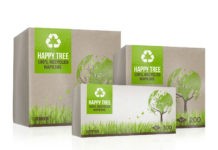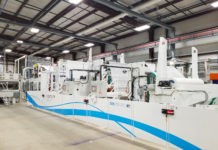Unbleached Miscanthus cellulose fibres combined with recycled office and hand towel paper, and unbleached fibres from recycled cardboard. Dr. Stefan Gräter, Head of Sustainability of the WEPA Group, talks to TWM.

The WEPA Group has introduced two additional raw material innovations as part of its sustainability strategy. The company said it has made fibres from recycled cardboard which form the basis for “extra soft and sustainable hygiene paper products”.
Secondly, it said that “one of the most sustainable fresh fibres in the world” now serves as a raw material: miscanthus.
It claimed that miscanthus has not yet been used by any other manufacturer to produce hygiene paper. Here, Dr. Stefan Gräter, Head of Sustainability of the WEPA Group, discusses the R&D behind the innovations.
TWM/1: WEPA Group has recently launched its “mach m!t PURE” product through its Consumer Business Unit, while WEPA’s Professional Business Unit will launch “Satino by WEPA PureSoft” and “BlackSatino GreenGrow”. What is unique about theseproducts?
“The three products are made from innovative and sustainable raw materials: “mach m!t PURE” and “Satino by WEPA PureSoft” are mainly made from recycled cardboard. The production of “BlackSatino GreenGrow” hygiene paper builds on Miscanthus cellulose fibres which are combined with recycled office and hand towel paper. What all the products have in common: outstanding sustainability and quality characteristics. They are all made without fibre bleaching and are premium-soft thanks to innovative production processes.”
TWM/2: What was the reason for launching these products?
“Sustainability plays an essential role at WEPA. We are the European market leader in the production of hygiene paper made from recycled fibres and we carefully select our raw materials from a sustainability perspective. After all, the raw materials we use to produce our hygiene papers have a major impact on the ecological footprint. By 2030, we strive to increase the share of recycled fibres and alternative fresh fibres in the raw material mix to 60%, thus reducing the ecological footprint of the fibres used by 25%. Therefore, we did a lot of research in the field of additional sustainable raw material sources and we are very pleased to be able to offer innovative products made from recycled cardboard and Miscanthus now.”
TWM/3: Will you look to produce them as private label products also, or will they always be branded?
“The new products are launched in our WEPA brands “mach m!t”, “Satino by WEPA” and “BlackSatino”. However, the use of recycled cardboard as raw material is also being considered for private label products with exclusive customers.”
TWM/4: How are “mach m!t PURE” and “Satino by WEPA PureSoft” produced?
“Mach m!t PURE” and “Satino by WEPA PureSoft” are made from 100% recycling fibres mainly consisting of recycled cardboard. To be able to use this fibre source as a raw material for the production of hygiene paper, WEPA has further developed the production process. The diligent selection of fibre sources and an innovative production technology makes the products extra soft. Since no fibre bleaching is used, the light brownish colour gives the paper a natural appearance, additionally emphasising the sustainability aspect.”
TWM/5: And how is “BlackSatino GreenGrow” produced?
“The special ecological performance of “BlackSatino GreenGrow” hygiene paper builds on unbleached Miscanthus cellulose fibres which are combined with recycled office and hand towel paper. Miscanthus has not yet been used by any other manufacturer for the production of hygiene paper.
“WEPA has developed a unique dissolving process to gain the fibres from locally planted Miscanthus sources.”

TWM/6: How sustainable are these products and why?
“Mach m!t PURE”, “Satino by WEPA PureSoft” and “BlackSatino GreenGrow” are highly sustainable products because we do not bleach those products and, of course, due to the raw materials used; WEPA has high expertise and is pioneering innovations in the area of recycled fibres for years.
“By using recycled fibres that have already gone through several life cycles in other products, our products consistently take up the idea of the circular economy. It is good to reuse those fibres especially for disposable products such as toilet paper. In order to assess a product in terms of its ecological footprint, it is important to consider the entire value chain – a look at the energy used to produce the fibre shows that on average, the recycling of fibres from recovered paper is 50% more energy efficient than the production of wood-based fresh fibres.
“On the other hand, with Miscanthus we can now use one of the most sustainable fresh fibres for our products. Miscanthus is a renewable, natural raw material rich in cellulose which grows under very mild conditions. Moreover, the plants grow locally without the need for fertilisation, irrigation or the use of pesticides. They reach their mature size every year with a lifespan of about 20 years. Except for the annual harvest, the soil is not disturbed all year round and the soil structure improves over the years. The plant’s demands on the soil are very low since it has its own internal nutrient cycle which does not deplete the soil. Due to the very high yield per hectare area, Miscanthus has a relatively small ecological footprint compared to standard wood-based fresh fibres, when it is cultivated on existing fields.”

TWM/7: How vital is it that the tissue and towel industry continue to innovate with products such as these?
“From our perspective, sustainable innovation is crucial for the tissue industry. On the one hand, sustainable raw materials, products and production processes. But on the other hand, also sustainable and innovative service concepts such as the towel paper circulation concept we offer to organisations and companies in the Netherlands and Germany. Since 2018, we were able to recover and reuse paper towels with this innovative concept. The aim of innovations must be, to reduce the consumption of fibres as much as possible, and to keep precious renewable resources in recycling loops as long as possible.”































